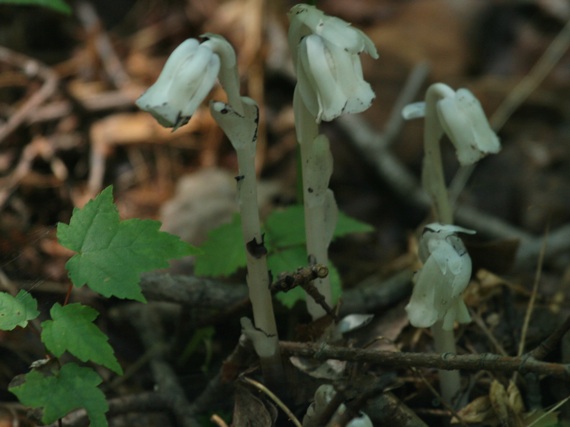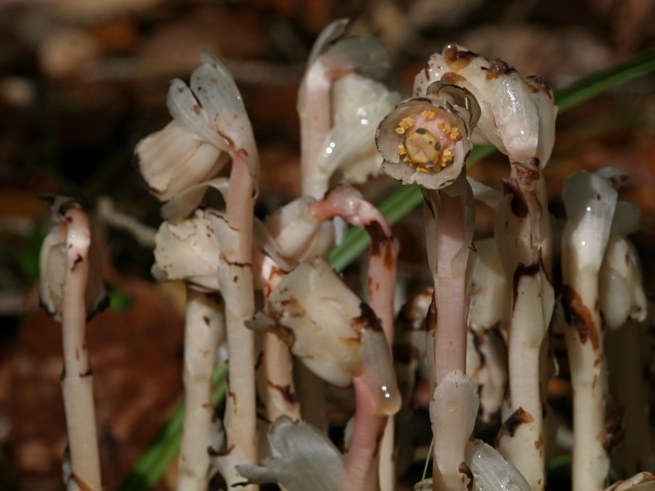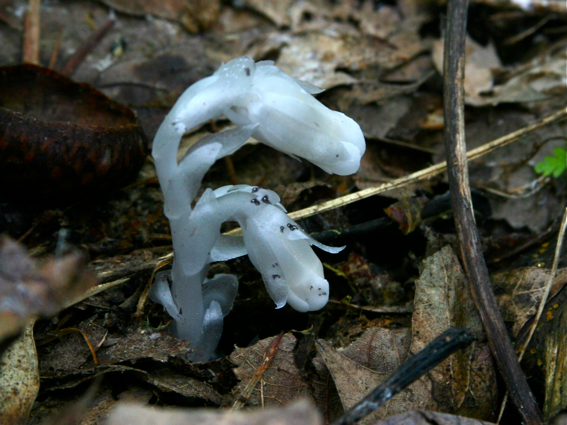The Nature
Observer’s Journal
The Nature
Observer’s Journal

Indian Pipes
The Ghost Flower
Chuck Tague
Walk in the woods during the next few weeks and you will come across a ghostly, translucent, all white plant. Sometimes called Ice Plant, Corpse Plant, Ghost Flower, or the Dead Man’s Fingers -- this eerie growth is Indian Pipes, Monotropa uniflora. Smooth, glasslike and about six or eight inches high, it resembles long, thin mushrooms. However, it is not a fungus but a wildflower -- a flowering plant with all the necessary flower parts. All it lacks is the ability to photosynthesize.
Few flowers bloom in the deep woods in summer, but shortly after the solstice the first Indian Pipes poke out of the dark, moist soils. Unlike most flowering plants, Indian Pipes do not need sunlight, nor do they produce chlorophyll. Instead, they form an association with fungi. Indian Pipes have no leaves, only scalelike coverings along the stalk.

Until recently botanists considered Indian Pipes a saprophyte, or a plant that takes its from nutrients from decaying plants. No plants, however, are capable of breaking down organic material. The only true saprophytes are fungi.
Indian Pipes are epiparasites, or myco-heterotrophs. Their roots parasitize the roots of mycorrhizal fungi from the family Russulaceae. The fungi have a mutualistic relationship with oaks. The fungi add their immense network of fine, white filaments (mycelia) to the oaks root system. This greatly increases the tree’s ability to acquire moisture and minerals. The oak’s green leaves produce food for itself and the fungi.
The fungi get food from the oak -- the Indian Pipes pilfer food from the fungi and provide benefit to neither the tree nor the fungus.
As you examine the mysterious clusters of Indian Pipes, look for stems that droop downward like a “peace pipe.” These are freshly opened flowers that have yet to be pollinated. After a fertilizing agent visits the plant, the stem turns straight up. On the end of the stem that is now standing tall, a seed-bearing capsule forms. The capsule eventually splits down the sides and the sawdust-like seeds are blown out. The insects responsible for fertilizing Indian Pipes have yet to be identified.
As mysteriously beautiful as the Indian Pipes are, do not pick one. They are much more attractive on the forest floor. Once picked, the Indian Pipe turns black and shrivels before your eyes, as if to deny you its beauty for denying it the opportunity to reproduce. They stubbornly resist any attempt to transplant them. It is impossible to recreate their complex relationships in a garden.

Wednesday, July 1, 2009
